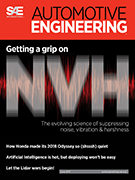Magazine

Automotive Engineering: June 2017
2017-06-01
Tackling NVH one dB per day New tools and technologies are helping engineers reduce vehicle Noise, Vibration and Harshness. Artificial intelligence becomes a reality Automakers could be among the leaders in deploying AI in free-standing, high-reliability environments. But developers must determine how to mitigate undesirable side-effects. Lidar: autonomy's mission-critical component Automated-driving capability likely won't happen without Lidar. But what technology-and at what price? Formula One goes longer, lower, wider for 2017 New rules make the cars faster and more aggressive-looking, with a wider track, wider tires and bigger wings. Editorial: Core Ford, New Ford...OneFord? SAE Standards News Seeking a common language for vehicle automation Supplier Eye Are you innovating for NVH?









